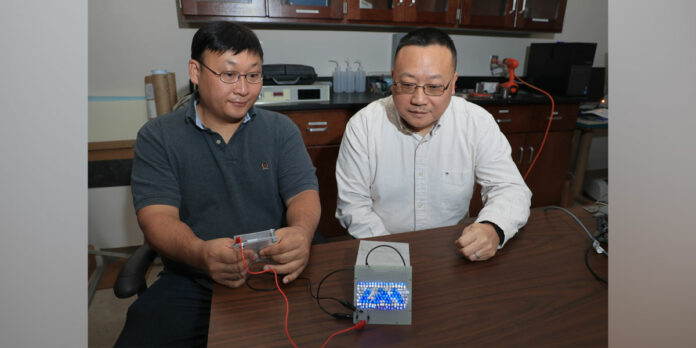HUNTSVILLE – A bit of laboratory serendipity led University of Alabama in Huntsville researchers to a simple mechanical way to generate electricity to operate electronic devices.
Triboelectric nanogenerators use multiple layers of different materials to generate electricity. While testing a triboelectric nanogenerator in the adaptive structures laboratory of Dr. Gang Wang at UAH, postdoctoral research assistant Dr. Moonhyung Jang observed something unusual.
“During a finger-tapping test performed by Dr. Jang, a Scotch tape was introduced on the
top to prevent electric shock,” said Wang, an associate professor of mechanical and
aerospace engineering and the project’s principal investigator.
“An unexpected high voltage was observed. After a careful investigation, we figured out
that the tape layer is the reason to cause this. This led to our invention that introduces tacky materials to improve the performance of triboelectric generators.”
Consisting of a metalized polyester sheet that’s similar to shiny gift-wrap plastic material
and a double-sided tape with an acrylic adhesive layer, the configuration is simple and
cost effective.
“A contact-and-separation motion is required for the current triboelectric generator design,” said Jang, the paper’s lead author. “In our recent paper, we demonstrated energy harvesting when someone is walking by using a shoe integrated with the current triboelectric generator. We can modify the design to meet other applications accordingly.”
Supported by the company Materials Sciences via a U.S. Army Small Business Innovation Research (SBIR) phase 2 program, the goal of the project is to provide an energy harvesting solution that will power sensors and electronics to track flight times of aviation and missile structures. In the phase I effort, Wang and his team demonstrated the galloping energy harvesting concept using piezoelectric materials.
Jang joined the group to support the SBIR phase 2 program in 2021. Jacob Lee of Toney, a UAH alum, is a paper co-author and an engineer at the U.S. Space and Missile Defense Command.
“We are grateful, as well, for the technical guidance from Dr. Simon Chung, vice president of research and development at Materials Sciences LLC,” Wang said. Chung is also a paper co-author.
“A simple idea was to try a triboelectric nanogenerator design by modifying the surface
structure of a triboelectric layer using the atomic layer deposition technique,” said Wang. “This is why we invited Dr. Yu Lei to help us build such prototype in his lab by creating oxidized layers.”
Lei is the interim chair and an associate professor in the Department of Chemical and
Material Engineering, and it was that prototype that Jang was testing when the readings were noticed.
“Moreover, Dr. Lei also contributed to our current paper and provided lots of suggestions
and comments from a material scientist’s perspective,” said Wang.
The investigators are exploring different concepts to improve the device’s performance.
The scientists used an LED display to illustrate the concept, but they say it has much wider
potential applications.
“The ultimate goal is to provide a power source for sensor and monitoring systems in different engineering applications,” said Jang. “We already conducted some tests to
demonstrate a wearable sensor concept for the human body.”
Don’t miss out! Subscribe to our email newsletter to have all our smart stories delivered to your inbox.



